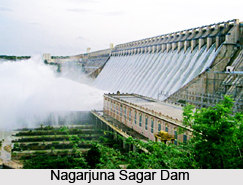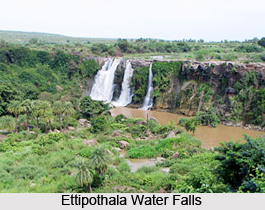Guntur is a district of the South Indian states, Andhra Pradesh. This district has various tourist places in and around it. Some of them are given here:
Amaravathi
Amaravathi is a famous pilgrim centre of the Buddhists. It is situated about 35 km west of Guntur. It is on the sumptuous banks of the splendid river Krishna. It is said that a holy Buddhist Stupa stood here over two thousand years ago. It measured about 36.5 ft across and about 29 m in height. The stupa was built of special bricks baked in kiln, faced with glossy slabs made of marbles. There are beautiful carvings on it, which displays events from the sublime life of Buddha along the crown of its rotunda and either sides of the railing. It can be reached by road from Guntur, Vijayawada or Hyderabad which are about 35, 82 and 350 kms respectively.
The railway stations at Guntur and Vijayawada are 36 and 82 kms away. The Vijayawada airport is 65 km from Amaravathi. Good accommodations are available for the visitors at Guntur and Vijayawada.
Sri Amareswara Swamy Temple
This is an ancient temple, which is dedicated to Lord Shiva. It stands on the wide banks of the charming river Krishna. As per the legends, it is said that the `Linga` here is found in its usual form. It was installed by `Lord Devendra`, the head of `Devas` at the end of `Dwaparayugam` one of the four cyclic periods of time, in the order of millions of years.
Archaeological Museum
A large number of extraordinary sculptures can be seen in this museum. Among those ancient sculptures are the lotus medallions, lotus carved crossbars of railings, panels depicting Jataka tales, the valued `Bodhi` tree and devotees in front of it in the act of worship, Dharma-chakras and numerous other figures. These are the beautiful reflections of the elegant Indian art. These sculptures belong to a time period from 200 BC to 250 AD.
Vaikuntapuram
It is the holy abode of the Lord Vishnu and so the name. It is situated about 5 km from Amaravathi. This cave temple is situated on a beautiful hill, which is dedicated to Lord Venkateswara. The presiding deity of the temple is at Thirumala Thirupathi in Chittoor district. The legends say that Lord Venkateswara manifested here. Recital of Rosary and performance of Pujas is carried out everyday here.
 Nagarjunasagar/Nagarjuna-konda
Nagarjunasagar/Nagarjuna-konda
This is a beautiful dam across the mighty river Krishna. It is placed in a picturesque environment and serves multipurpose. The ancient name of the place was Vijayapuri. It was the ancient capital of Ikshvaku Empire. In the year 1926, the initial excavations were carried out here. Some fascinating relics, Mahachaita, the sacred Buddhist stupa, the ramshackle remains of a once sturdy university, vihara etc were recovered here. It also discovered ancient creativity and the reticent ruins of a number of grand ancient monuments.
Nagarjunasagar Srisailam Wildlife Sanctuary
This beautiful sanctuary consists of a number of fascinating wildlife species. It has undulating sylvan landscape ranging between 200 and 900 meters in altitude. It is surrounded by Mahaboobnagar, Kurnool, Prakasam, Guntur and Nalakonda districts. A picturesque lake can also be seen here on way to Srisailam from Nagarjunasagar. It is about 22 km from Macherla by road and 150 km from Hyderabad and 180 km from Vijayawada. There are regular busses between Macherla and here. The nearest railway station is at Macherla and the nearest airport is at Hyderabad.
Bottiprolu
This is another ancient sacred Buddhist place of Andhra Pradesh. It is situated in the Repalle Taluk, about 320 km from Hyderabad. One can see the sacred `Maha stupa` here, which had one of the ancient inscriptions. It has several sacred relics of the Buddha. The huge dome of the massive stupa is 40 meter in diameter. There is a 2.4 meter drum with oblong stone slab, which is juxtaposed with pilasters.
Three stone receptacles were discovered here, and its reference can be seen in the inscriptions here. One of them include articles such as the Blackstone casket, copper beads, precious pearls and ornate jewellery, glittering flowers made of gold, two thin pieces of gold with three pieces of bones, and other jewellery.
 Ettipothala Waterfalls
Ettipothala Waterfalls
This waterfall is situated about 6 km northwest of Macherla. It was created by the mighty river Krishna and the sizzling rivulet Chandravanka. It was formed in the confluence with Krishna at a point before the ravishing falls where the turbulent waters fall from a height of 21 meters.
Undavalli
It is situated on the gigantic banks of the wonderful river Krishna. This sylvan region has enthralling caves, which has excellent architecture. The sculptures found here are compared with those of the world famous Ajanta caves. The Vishnukundin rulers of 420 AD are believed to have been closely involved with these splendid caves.
Pedapulivarru
The beautiful temple dedicated to Lord Narendreswara Swamy is found here. This god is one of the various forms of Lord Shiva. This temple was built so technically that the rays of the Sun fall directly on `Lingam` at sunrise on every Sankranti day. The temple also has a huge bronze image of Lord Nataraja.



















